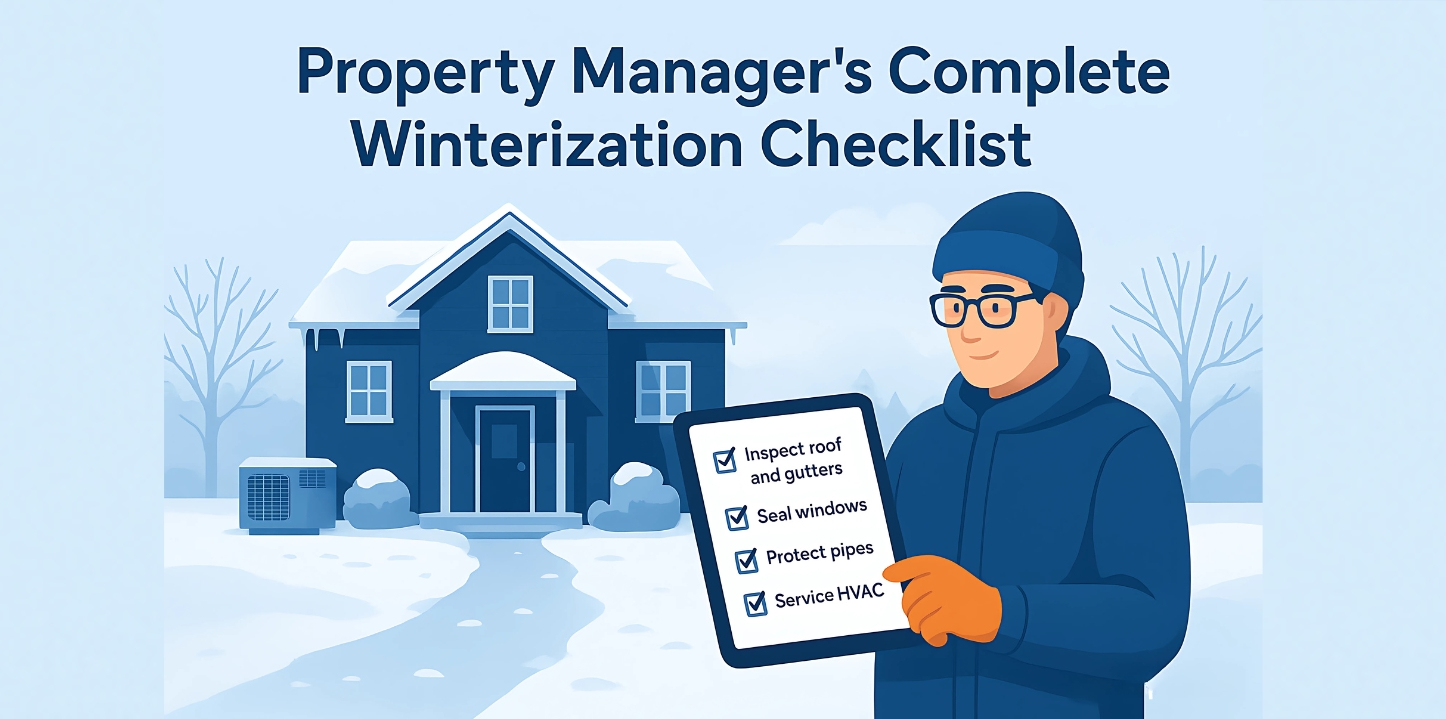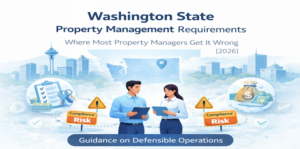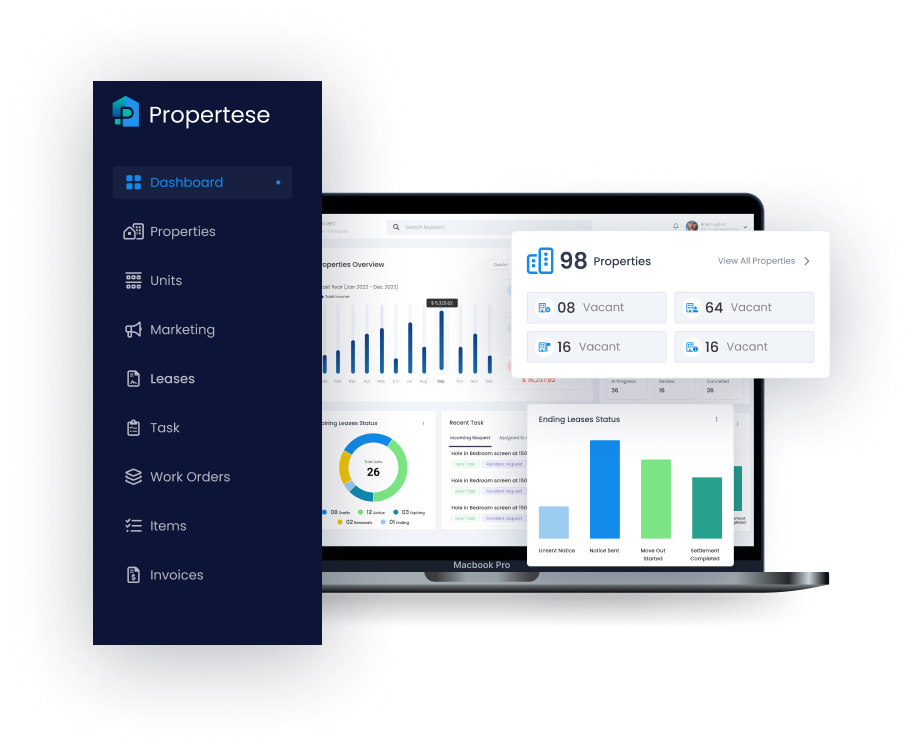
Each winter, property owners prepare for one of the most challenging seasons in the business of real estate. Clogged pipes, broken boilers, leaky units, and icy walkways aren’t simple complaints from tenants. They become lawsuits, surprise expenses, and sleepless nights for emergency repair calls.
Think about it: one burst pipe alone can cost more than $10,000 in damages (FEMA). For rental communities or multi-family residences, this number multiplies quickly. And although tenants expect comfort, they also blame property managers when things go wrong.
It’s why having a complete winterization checklist is important. In this playbook, we’re going to guide you through each step you need to protect your properties, safeguard tenants, and get control over your expenses.
Why Does Winterization Checklist Matter for Property Managers?
Property managers wear many hats. A caretaker, budget analyst, tenant liaison, and risk manager. Winter magnifies all of these roles. Without proactive planning, small oversights can snowball into costly crises.
Here’s why winterization should be at the top of your to-do list:
- Tenant Safety: Heating failures or icy walkways create immediate hazards.
- Property Value Protection: Prevent structural damage caused by ice dams, leaks, and frozen pipes.
- Legal Liability: Neglect of maintenance requests or slip-and-fall accidents may result in lawsuits.
- Energy Efficiency: HVAC maintenance and insulation decrease utility bills.
- Tenant Retention: Tenansta and residents who feel more cared for are less likely to leave.
In fact, research indicates that preventive maintenance saves 12–18% in long-term costs. If tenant satisfaction is a goal, you’ll also find our blog on resolving issues and retaining residents helpful, it explains how good maintenance and communication go hand in hand.
Quick Winterization Checklist for Property Managers

Take a bird’s eye view of this winterization checklist with essential winterization measures property managers need to undertake:
- Check and service heating systems
- Seal windows and doors to prevent drafts
- Insulate exposed pipes to avoid freezing
- Arrange snow and ice removal services
- Clean gutters and check the roof
- Check smoke and carbon monoxide alarms
- Winterize empty units to avoid damage
- Inform tenants about winter rules
Keep reading for a detailed breakdown of each step, with examples and cost-saving strategies.
How Should Property Managers Prepare HVAC and Heating Systems?
When tenants call at 2 AM about a heating outage, you need to take this on as a potential health and safety risk. Preparing HVAC and boilers early is non-negotiable.
Steps for HVAC & Heating Prep
- Annual Inspections: Have certified technicians inspect boilers, furnaces, and central HVAC systems.
- Filter Replacements: Clogged filters make the system work harder, increasing energy consumption and likelihood of failure.
- Emergency Contracts: Join forces with nearby HVAC contractors for 24/7 service coverage.
- Smart Thermostats: Install smart controls in public areas for energy efficiency.
To dive deeper, check out our preventive HVAC maintenance checklist for a step-by-step guide that property managers can adopt year-round.
How to Prevent Frozen Pipes in Rental Properties?
Frozen pipes are a property manager’s worst winter nightmare. As water freezes, it expands and will burst pipes and flood units.
Preventive Measures
- Insulate Pipes: Don’t forget basements, attics, and outside spigots.
- Let Faucets Drip: A drip of water keeps the water circulating, and it won’t freeze.
- Seal Cracks: Seal drafts in walls or crawlspaces that let cold air reach the pipes.
- Vacant Unit Monitoring: Maintain thermostats at a secure level, even in vacant areas.
For managers juggling multiple properties, using modern property maintenance software like Propertese can make a difference.
What Exterior Maintenance Should Be Done Before Winter?
The outside of your property is your first line of defense against winter weather. Neglect it, and you’ll face water infiltration, roof leaks, and tenant safety complaints.
Exterior Winterization Checklist
- Clean Gutters & Downspouts: Prevent ice dams and water backup.
- Inspect the Roof: Look for missing shingles or weak spots.
- Trim Overhanging Branches: Heavy snow can cause branches to snap onto roofs or power lines.
- Seal Driveways & Walkways: Small cracks can turn into big problems when water expands and freezes.
For additional season-specific tips, see our complete fall maintenance checklist, which pairs perfectly with winter prep to ensure you’re covered year-round.
What Safety Checks Should Property Managers Run Before Winter?
Tenant safety is not seasonal, it’s year-round. However, winter requires special care because heating systems and enclosed spaces increase risks.
Must-Do Safety Checks
- Test Smoke & Carbon Monoxide Alarms: Critical when heaters run around the clock.
- Check Fire Extinguishers: Ensure they’re accessible and up-to-date.
- Update Emergency Contacts: Share a clear procedure for tenants in case of outages.
- Light Common Areas: Shorter days require reliable exterior and hallway lighting.
Strong communication is part of safety. Our blog on effective communication in property management shows how clarity reduces stress and boosts tenant trust.
How Should Property Managers Communicate Winter Rules with Tenants?
Winterization isn’t merely boiler and pipe work, it’s about expectation management with tenants. Confusion regarding heating policies or responsibility for snow can turn tenants sour.
Tenant Communication Tips
- Send Seasonal Newsletters: Write winter rules in straightforward language.
- Use Digital Portals: Post reminders regarding space heater usage or parking rules.
- Include Emergency Numbers: Tenants must know who to call during an electrical outage.
If you’re looking to improve tenant relations this season, try a software for tenant communication like Propertese that keep everyone on the same page.
How to Plan Snow and Ice Removal Effectively?
Slip-and-fall accidents are among the most common winter liabilities for property managers. A single lawsuit can cost more than an annual snow removal contract.
Best Practices
- Pre-Schedule Contractors: Secure agreements before the first snowfall.
- Stock Supplies: Salt, sand, and shovels must be readily available.
- Prioritize Walkways: Prioritize entrances, parking lots, and busy walkways.
- Document Everything: Maintain records of snow removal to protect against liability.
To learn how proactive maintenance approaches impact profitability, see our article on proven ways for property managers to lower maintenance expenses.
How to Winterize Vacant Rental Units?
Seasonal or vacant units tend to go unnoticed, yet they are at a higher risk since no one is present to identify issues.
Winterizing Vacant Units
- Drain Water Lines: Don’t let stagnant water freeze within pipes.
- Shut Down Appliances: Turn off unused appliances to conserve energy.
- Keep Heat On Low: Leave the temperature at least 55°F to avoid structural damage.
- Schedule Regular Inspections: Use digital tools and software to inspect remotely.
For a related angle, our ultimate rental inspection checklist ensures that inspections pick up small problems before they escalate to emergencies.
How Much Does Winterization Cost Property Managers?
Winterization expense is a function of property size, region, and infrastructure age.
- Per Unit Costs: Approximately $100–$500 for standard preventive measures.
- Major System Servicing: Boiler servicing and HVAC maintenance can cost $200–$1,000.
- Snow Removal Contracts: Average $1,000–$5,000 per year, depending on property size.
But the price of neglect? Much higher. Bursting pipes, roof damage, or liability suits can cost tens of thousands of dollars.
Budgeting is the toughest aspect of property management, especially when juggling multiple properties and tracking seasonal expenses across your entire portfolio. Propertese’s comprehensive reporting feature helps property managers gain complete financial visibility by automatically tracking winterization costs, maintenance expenses, and seasonal budgets across all properties in one centralized dashboard. With detailed cost reporting and budget forecasting tools, you can identify spending patterns, allocate resources more effectively, and ensure no property is left vulnerable to costly winter damage.
What Long-Term Strategies Reduce Winter Costs?
Winterization doesn’t necessarily conclude in the spring. Property managers who consider the long-term can save significant amounts of money and appeal to environmentally friendly renters.
Long-Term Investments
- Energy-Efficient Windows: Save up to 30% of heat loss.
- Smart Thermostats: Regulate temperature throughout units automatically.
- Tenant Education: Educate residents to identify leaks or drafts promptly.
- Green Upgrades: Eco-friendly practices save money.
Final Thoughts
Winter does not have to be a living hell for property managers. With a comprehensive winterization checklist, you can safeguard your buildings, please tenants, and maintain costs within budgets.
Rather than fear the season, use it as a chance to demonstrate to tenants that you’re interested in their comfort and security. In the end, this earns loyalty, decreases turnover, and positions you as a property manager who does his work well.
If you’re looking to manage these processes with technology, Propertese can help. From maintenance schedule to tenant communication, our platform simplifies every step so winter property management feels less like firefighting and more like strategy.
Table of Contents
Stay Updated
Subscribe to get the latest news, industry trends, blog posts, and updates...




